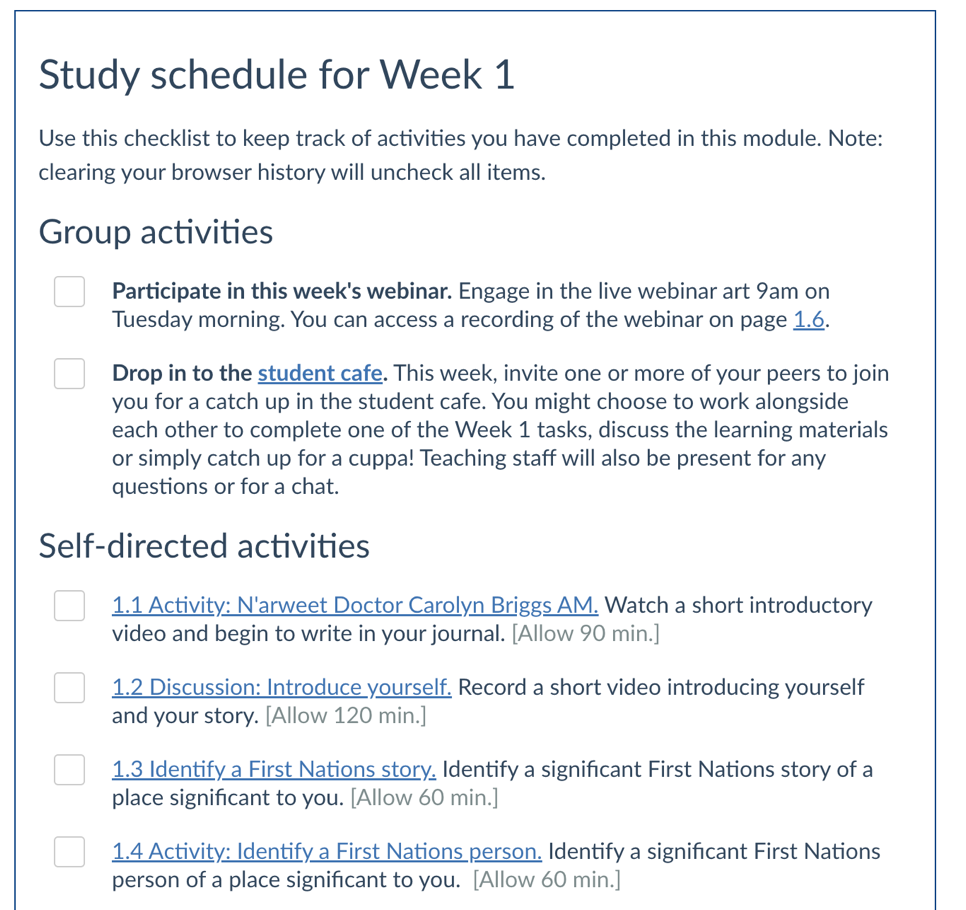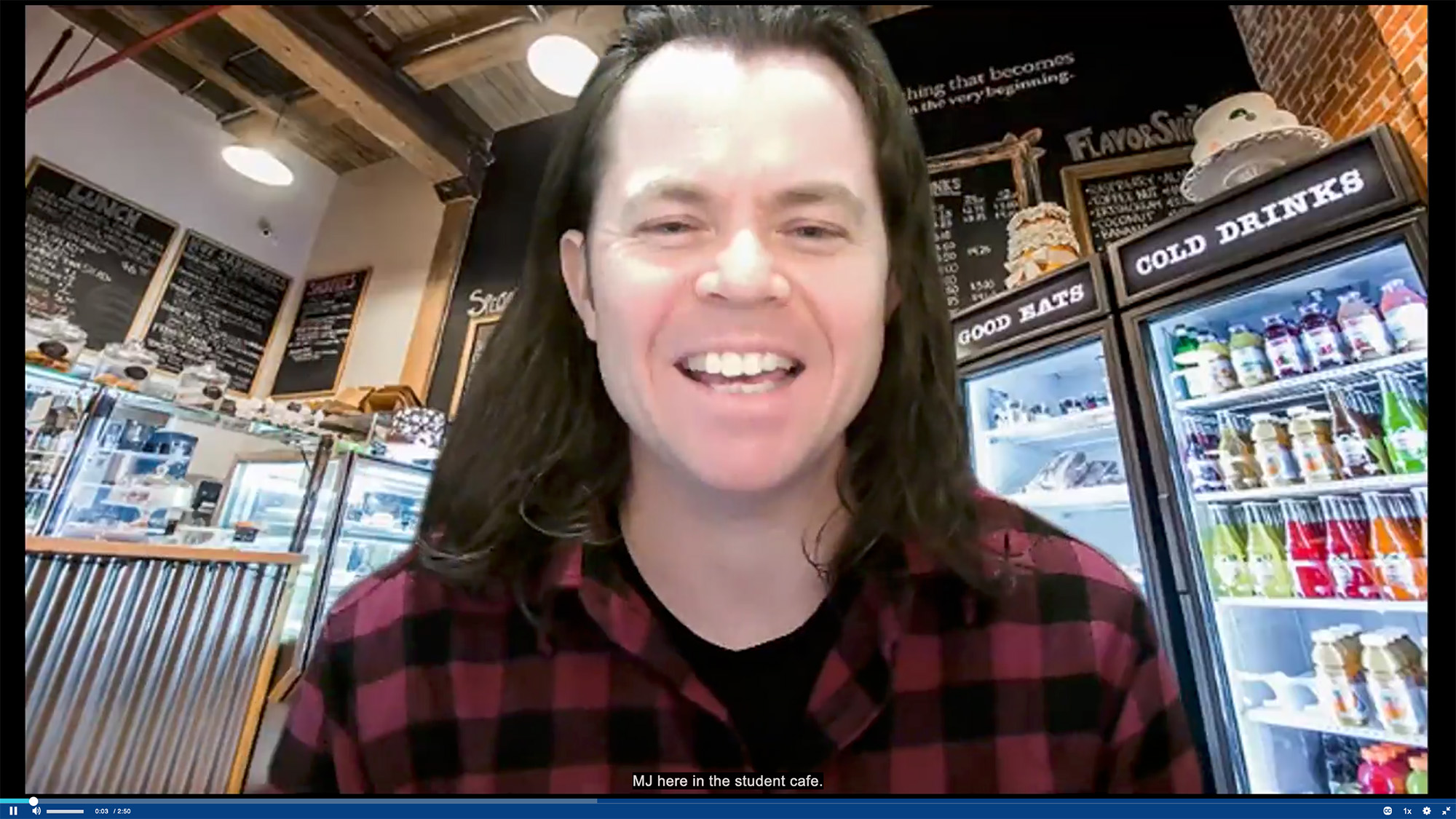Voices, community and Indigenous knowledge in online places of learning
Background
In 2020 the academic team at the Wilin Centre for Indigenous Arts and Cultural Development, including Tiriki Onus (Yorta Yorta | Dja Dja Wurrung, Subject Coordinator), Lauren Gower (trawlwoolway, Subject Coordinator), Megan McPherson (settler, Lecturer/academic developer) and Michael Julian (Koori, Tutor in Indigenous Arts and Culture), were awarded a FlexAP grant to redesign and redevelop AIND10004 Art and Indigenous Voice with Learning Environments. This Level 1 Breadth subject in the Faculty of Fine Arts and Music is designed to give students a solid basis from which to start engaging with Aboriginal and Torres Strait Islander creative and cultural practices, with a focus on connection to Country and Place.
When applying for FlexAP support to redesign the subject in an online mode, the team aimed to keep the voices at the heart of the subject and to maintain the relationship-building and sense of community fostered in their tutorials, while reducing the challenges inherent in the previous format. The subject team collaborated closely with Learning Environments Learning Designers Nathan Grieve and Annabel Orchard and Video Producer Pru Burns to address these challenges. Here Megan McPherson and Michael Julian speak about their experience of re-developing and delivering this subject.
The challenges
Coordinating guest speakers
One challenge of delivering this subject was the need to invite and schedule a series of guest speakers for weekly lectures. The voices of Indigenous leaders in culture, thought, art and activism are central to the subject. However, the coordination of speakers for each week, including the required permissions and intellectual property agreements to record Indigenous speakers, was proving to be time-consuming and stressful for the subject team.
Preparing tutorials and resources
The dependence on guest speakers created a secondary challenge of preparing for tutorials in response to the themes and issues raised by the speakers, as tutors often needed to deliver tutorials immediately after attending the lectures. As Megan McPherson says, “If you've never heard the lecturers before, you've actually got to come up with a tutorial on the spot to deliver within the next hour.” This allowed limited time and opportunity to source and provide students across the cohort with quality supporting resources to address the subject intended learning outcomes.
Physical locations
A third challenge was teaching a subject face-to-face on two campuses, both Southbank - where the Wilin Centre is located, and Parkville - where the lectures took place. According to Megan, the “shlep up the hill” to lectures at Parkville put pressure on the timetables of both students and staff located at Southbank.
Our approach
Guest interviews
Indigenous voices form the core of a series of online modules. As Megan tells us, “We learn with story – stories of people's lives, stories of long ago, and stories from now. Our storytellers guide the way.” Each two-week module begins with a pre-recorded interview or yarn with a leader in aspects of Indigenous culture, thought, art and activism. Pre-recording these interviews took the pressure off arranging guest lectures for a specific time and place, and allowed flexibility to accommodate the schedules of esteemed speakers including N'arweet Professor Carolyn Briggs AM PhD, Senior Elder of the Boon Wurrung; Professor Tony Birch (writer and academic); Daniel Riley (dancer, choreographer, creative producer and academic); Monica Weightman (musician and activist); Rachel Maza (Artistic Director, Ilbijerri Theatre); and Tiriki Onus (artist and academic, FAM Associate Dean, Indigenous and head of the Wilin Centre). Each speaker shares their own story and also their particular insight into a core theme of the subject to be developed and extended in the online modules, tutorials and conversations.
The interviews or yarns follow the lead of the speaker – or, in one example, the singer. Michael Julian says, “I think Monica Weightman's story is a beautiful example because it has spoken voice and song, and it breaks into song at moments, which is really powerful. And that's probably one of the first experiences the students would ever have of someone doing that idea of performance, which is very special in our faculty, but also the intimacy of that interview. To have that knowledge come through, and come through you”. The interviews include projected backdrops that set the scene and, as Michael notes, “gives them this expansive space which is about Place and Country”.
One yarn is literally about yarn. In this self-recording, Tiriki Onus demonstrates a traditional process of making string, while talking about the history and meaning of his practice, and invites students and colleagues to follow along in their own place. Megan says, “I think the yarning that Tiriki does when he is making string is really important. It grounds people in that idea of Indigenous knowledge and the way of sharing those Indigenous knowledges”.

Online activities and resources
Starting from the guest’s voices, the team developed modules of activities supported by carefully selected resources to extend and enrich the themes raised in the interview. Megan explains, “Those themes of sovereignty, of agency, of voice...the guest lecturer explains those within their own world experience. Then building upon that, (we provide) other examples of what voice looks like. So that students get a really granular picture of how one person understands this idea, but then they get these other diverse voices coming in and adding the richness and the context”. This approach enabled the teaching team to ensure that all students had consistent and equitable access to the activities, resources and support. Individual and collaborative activities include song-writing, community-making, story-telling and regular reflection. Curated resources are provided to students, who choose a theme or artist that inspires them to explore further for assessment. Says Megan, “I want to make sure that we're hitting those intended learning outcomes each time we teach... it was important to have scaffolding there for both tutors and our students.”

Community and safe spaces
It was essential to the teaching team to maintain the relationship-building and sense of community of their tutorials. Students can study in a fully online and asynchronous mode, with activities supported by online discussions. Optional online synchronous sessions support the learning activities in the modules, and drop-in sessions at the online ‘student café' are a place for informal questions, discussions and yarning.
The orientation module includes a section on trigger warnings, which explains how they have been presented in the subject, and demonstrates how students can create trigger warnings for any content they share in discussions.
The themes of water and its flow are used iteratively throughout as metaphors of Indigenous pedagogical approaches or Indigenous-influenced research and knowledge from creative and cultural approaches (Yunkaporta & McGinty, 2009; Somerville, 2013; Andrews, 2017). Reflection is integrated and integral. Using the metaphor of a river, Megan explains: “In the reflective questions students are asked to engage with each week, they consider some tough issues; like a weir or eel trap, a purposeful intervention into the environment helps students think about productive and generative ways... These weirs support the challenges of developing diverse interests and skills in engaging in culturally safe practices... in our river, we paddle the canoes together”.
The impact
For staff
“I think for staff, it was a bit revolutionary because we weren't madly trying to do stuff on the day, which was brilliant”, says Megan. “It was then about working out how we work on that online space, how we develop relationships in that online space. How do we set up the protocols?”. The teaching team have been able to monitor student activity online in order to identify students who may be struggling, and have a series of emails to make contact and ask if the students need support. Michael agrees, “That's actually working surprisingly well through the pandemic.”

For students
Following the redesign, Megan and Michael have observed that their students have been managing their time very well, and have been able to channel their personal sources of motivation. In keeping with the river metaphor at the heart of the module design, individuals have taken the opportunity to dive deeply into certain modules that held particular interest to develop further for their assessment tasks, and to stay on the surface for other modules. Megan says, "Students are choosing where they want to deep-dive, where they want to get involved in the material, which I think is a good thing because it shows where their interest lies, and working with their internal motivators of ‘I really want to find out about this stuff’, and I think that's been quite successful.”
Michael notes that the online format has supported students to develop confidence in discussing Indigenous issues. He observes, “They liked having it as text-based. I think that helps with removing a barrier, in talking about difficult things. I think that's a big bonus about it”. Megan adds, “And also the student presentation assessments are recorded so they could redo them, they could script them, they could work in that space in very measured ways. Part of our thinking was actually that makes it a bit safer for students to think through how they wanted to present themselves in that space”. For Michael, this supported students to develop the key Melbourne Graduate Attribute of active citizenship, with an understanding of and deep respect for Indigenous knowledge, culture and values. “We can really talk about that difficult stuff because we're coming from a strength-based position in everything that we're doing in the subject...it also helps students to then understand where they can go to after the subject, how they can contribute, here from the southeast, or anywhere here in the continent”.
What’s next?
To see what is involved with working with Learning Environments on your subject see Flexible Academic Programming (FlexAP) and Learning Environments support for FlexAP or to discuss your ideas for your subject contact Learning Environments.
References and resources
- Andrews, S. (2017). Many ways learning: Indigenous Curriculum framework. Faculty of Medicine, Dentistry & Health Sciences. The University of Melbourne.
- Gauntlett, D (2011). Making is Connecting. Polity Press.
- Kara, H., Lemon, N., Mannay, D., and McPherson, M. (2021). Creative Research Methods in Education. Policy Press, UK.
- Onus, T. and McPherson, M. (2021). 'Module: Making String' [Video]. University of Melbourne.
- Somerville, M. (2013). Water in a dry land: Place-learning through art and story. Routledge.
- Ungunmerr, M-R. (2017). To be listened to in her teaching: Dadirri: Inner deep listening and quiet still awareness. EarthSong Journal: Perspectives in Ecology, Spirituality and Education, 3(4), pp.14-15.
- Yunkaporta, T., & McGinty, S. (2009). Reclaiming Aboriginal knowledge at the cultural interface. The Australian Educational Researcher, 36(2), 55-72.